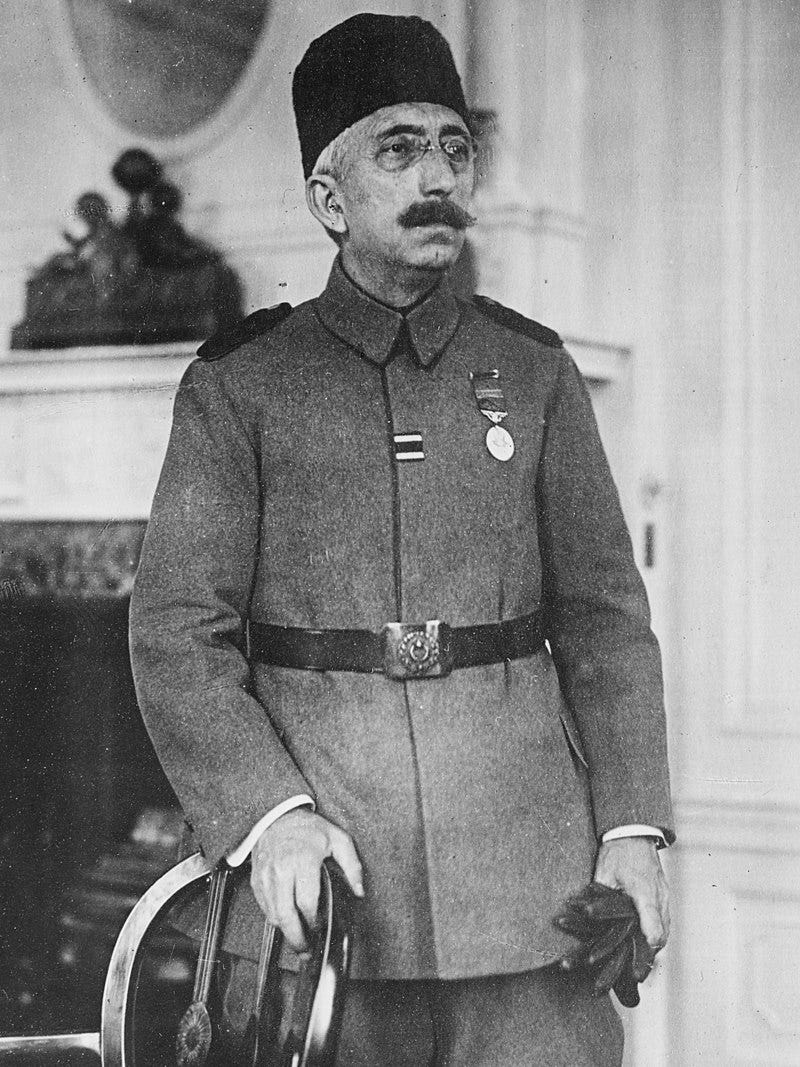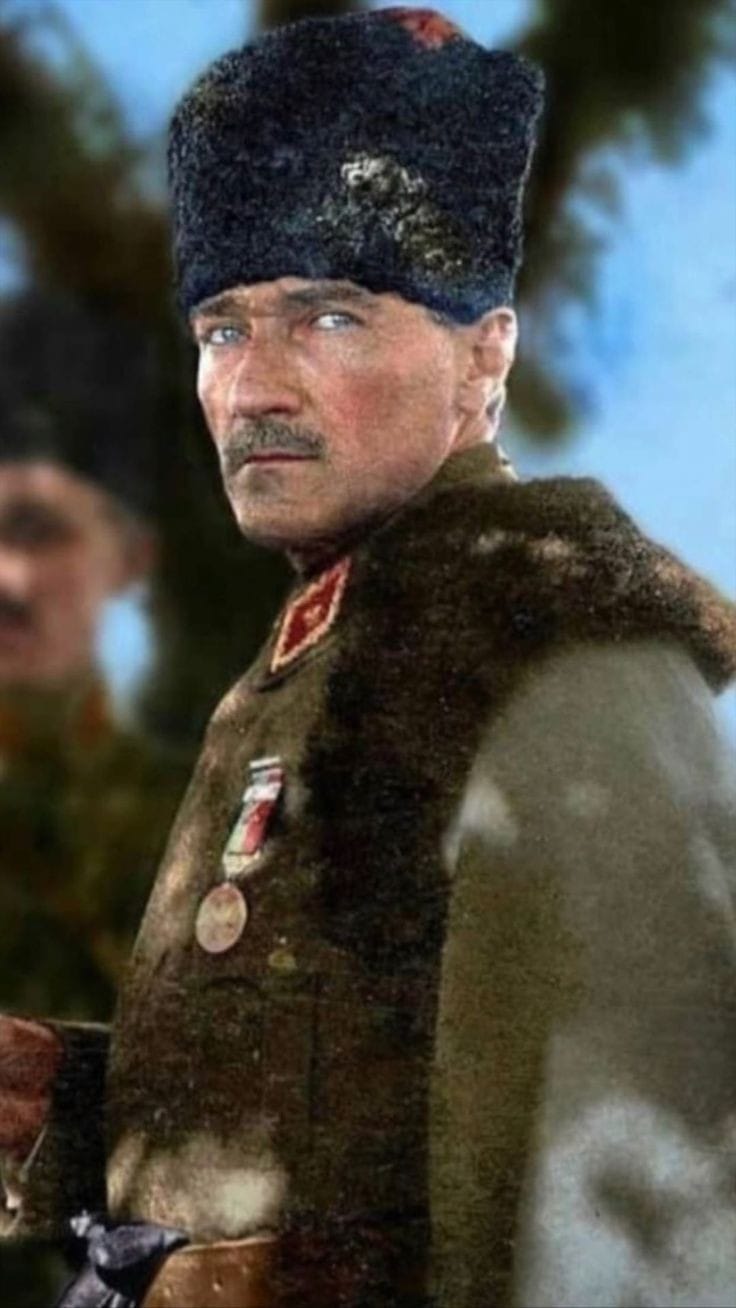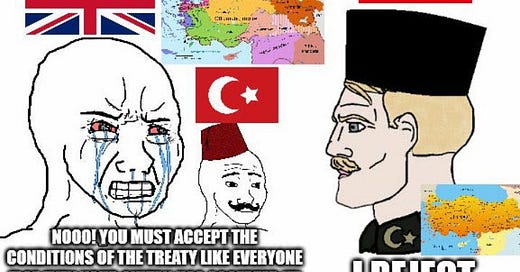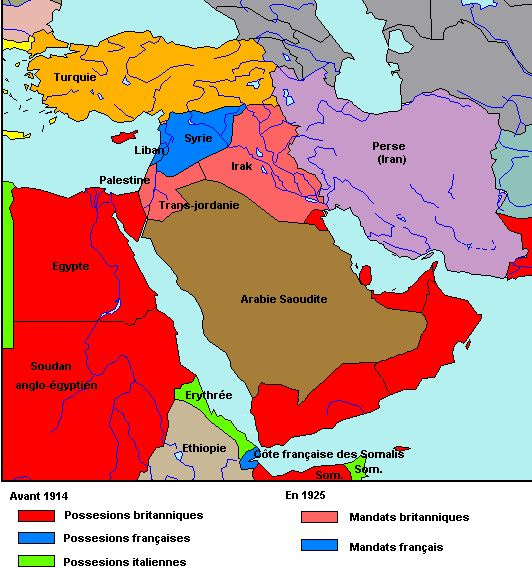Explain a Meme: How Turkey almost became the "Middle East"
The Treaty of Sevres is unknown in America, but it extended World War I an additional four, bloody years in Anatolia
Modern Turks trace their history to two treaties signed in faraway, western European countries: the Treaty of Sevres (1920) and the Treaty of Lausanne (1923). I see reference to these treaties so often here, that I have taken it upon myself to learn more about them.
And when I learn, dear reader, you learn, too. That’s the purpose of this substack.
First the meme, sent out on X via @BalkanMemesTr just before the 100th Anniversary of the Turkish Republic.
Let’s set the scene, then look at the meme.
The setting
Post-World War I. The Ottoman Empire had allied itself with the Central Powers (Germany, Austria-Hungary, Italy* and Bulgaria). It had fought a disasterous war against the Russian Empire in the Caucasus, losing significant territory. But it had held off the Brits, French, Aussies and Kiwis at Çanakkale, an episode known in the West as the Battle of Gallipoli (1915).
The Ottoman Empire, still headed by the Sultan but under the control of a junta known as the Committee of Union and Progress, better known as the “Young Turks,” sued for peace ten days before the Armistice on the Western Front. A British expeditionary force was making its way up from Syria. French and Greeks were massing in Bulgaria, ready to invade Thrace (the plain stretching westward from Istanbul into Europe, still a part of Turkey today).
The Characters
The aggressive-crying guy has a Union Jack over his head. He represents Britain, but he also represents a legion of other imperialists who sought to carve up Ottoman lands for, uh, more European domination. (I still struggle to believe this happened: nations that had sacrificed millions of men for pursuit of empire in — checks notes — Namibia and Tanzania, were still grappling for territories that didn’t belong to them.)
The guy in the fez with the mustache. That’s the sultan, Mehmed VI, the Osman family member stuck with the hot potato of empire at the time of armistice. He interited the throne from his brother, Mehmed V, just 4 months earlier. He was a puppet of the British forces who occupied Constantinople (as it was still known) after the armistice.

The guy on the right with the circassian cap and striking blond hair. That’s Mustafa Kemal Pasha, the savior of Turkish forces at Gallipoli and the future founder of the Turkish Republic.

The Caption
“No!!! You must accept the conditions of the treaty like everyone else,” say the Brit and the Fez. “Even your sultan has accepted it!”
“I reject,” says Mustafa Kemal
The Treaty
What treaty are the Brits and the sultan trying to get Mustafa Kemal to accept?
Sevres is a city on the outskirts of Paris that hosted a peace conference a year after the Versailles Treaty carved up the German and Austro-Hungarian empires and, uh, “made the world safe for democracy” as America’s delusional president tried to pitch it at the time.
At Sevres, the empire on the chopping block was Ottoman, which had ruled from the Balkans to the Persian Gulf for the previous 400 years. Britain and France had already carved up the Middle East with their Sykes-Picot Treaty, giving Palestine and Iraq to Britain, Lebanon and Syria to France. Now they had their sights set on Anatolia.
They weren’t the only ones. Greece staked a claim to Smyrna and Thrace. Italy had occupied Rhodes and the islands of the Dodecanese. Armenians and Kurds wanted homelands of their own.
Let’s take another look at the map referenced in the meme.
It’s hard to grasp the map, because the borders were in a state of flux, even as delegates met in Sevres to satisfy their imperial fantasies. Greece had invaded in May of 1919, landing in Smyrna and pushing well beyond the borders of the province (the eastern end of the “Greek Zone” on the map shows their progress as of 1920; they would make it almost to Ankara before they were routed by Mustafa Kemal — that guy again — in 1922 and expelled from Anatolia).
The French had moved up from Syria to take much of the Mediterranean coast as far as Adana. Their territory theoretically reached to the headwaters of the Euphrates, and spanned territory claimed by Kurds.
Meanwhile the Italians were racing to claim the western Mediterranean coast for themselves. The Brits controlled both the Dardanelles and the Bosphorus and occupied the prime real estate of Constantinople.
What part of Anatolia was left for the Turks? It was the yellow area around Ankara and along the central Black Sea coast. An empire that had ruled on three continents would be reduced to an arid scrap of north-central Anatolia.
No wonder the Turk in the meme says, “I reject.”
(Note, the map behind the Turk is the full map of Turkey as it stands today. That map is a big reason why Turkish nationalism remains so strong, despite Kurdish efforts for autonomy in the southeast: Turks fought on the battlefields of Anatolia and toe-to-toe with imperialists in boardrooms in France & Switzerland for every square mile of that map.)
So What Happened?
War. There was a lot of war.
The invasion of Smyrna, on 15 May 1919, galvanized Turkish public opinion. The Greek expeditionary force had met no resistance from the Ottoman troops in the city. The Sultan seemed willing to go along with any partition that Britain proposed.
Mustafa Kemal, a colonel at the time of the Battle of Gallipoli, and a military inspector when Smyrna was occupied, moved into the interior of Anatolia to build a resistance movement. Turkish elites also left Constantinople to join him.
The future of Turkey would no longer be determined by the House of Osman. It was up to Turks to shape the future of their country, and in Mustafa Kemal, they had the leader they needed.
Meeting little resistance from the Ottomans, Greek forces pushed into central Anatolia. The Greeks had advanced so far, the Treaty of Sevres was moot, and Turks were brought in to negotiate a new territory for a partioned Anatolia.
By 1921, however, Kemalist forces had built the strength to stop the Greek advances, first at İnönü (in April), then at Sakarya (in September), leading to a one-year stalemate.
As the Greeks were bogging themselves down, the French, Italians, and British were losing the heart to fight the acendant Turkish forces. On August 30, 1922, the Greek Army was routed at the Battle of Dumlupınar and fled for the coast. By the 9th of September Smyrna was back in Turkish hands. It is a day still celebrated here in Izmir every year as “Liberation Day.” Britain, France, Italy and Greece had no choice but to sue for peace.
In November 1922, delegates moved to Lausanne to hash out a new treaty. This one left the map of Turkey largely the way it remains to this day. Mustafa Kemal had wanted the Mosul province of present-day Iraq. That was given to Britain by the League of Nations.
What does this Mean for Today?
Just take a look at Britain and France’s former colonies in the Middle East.
Syria and Lebanon (France) are failed states, the former mired in a civil war that is beginning to echo the 30 Years War where outside powers ravaged Germany in the 17th Century. Palestine (Britain) is once again at war and, thanks to America, Iraq is hardly stable.
Meanwhile nations that maintained independence, Turkey and Iran are able to care for themselves. I’m not claiming that they have perfect systems of government and ideal human rights records. But they are stable regimes.
I don’t think that would have happened had they been colonized and exploited by England, France, and Italy in the way their neighbors were.
And that’s the message of the meme for today.





